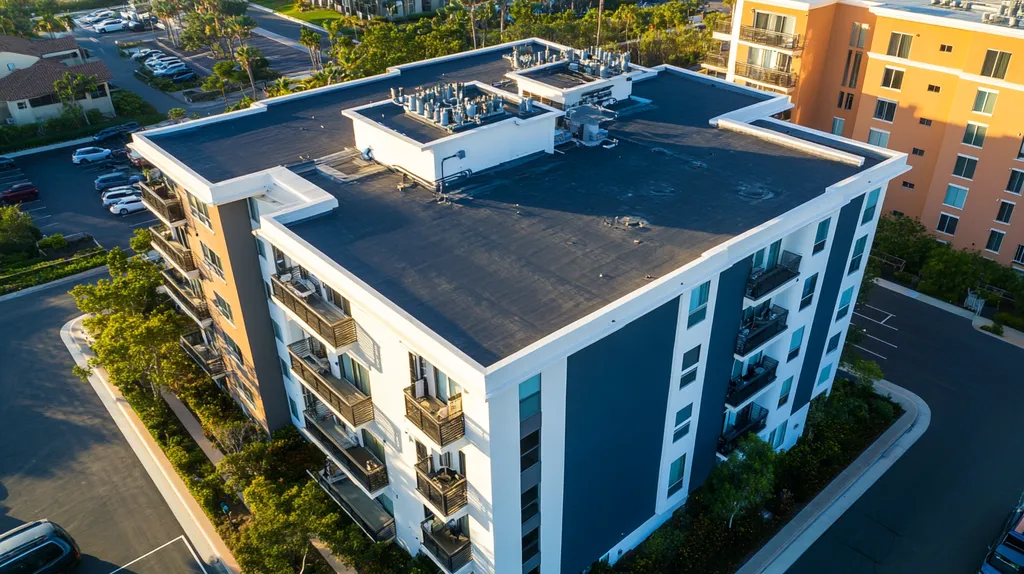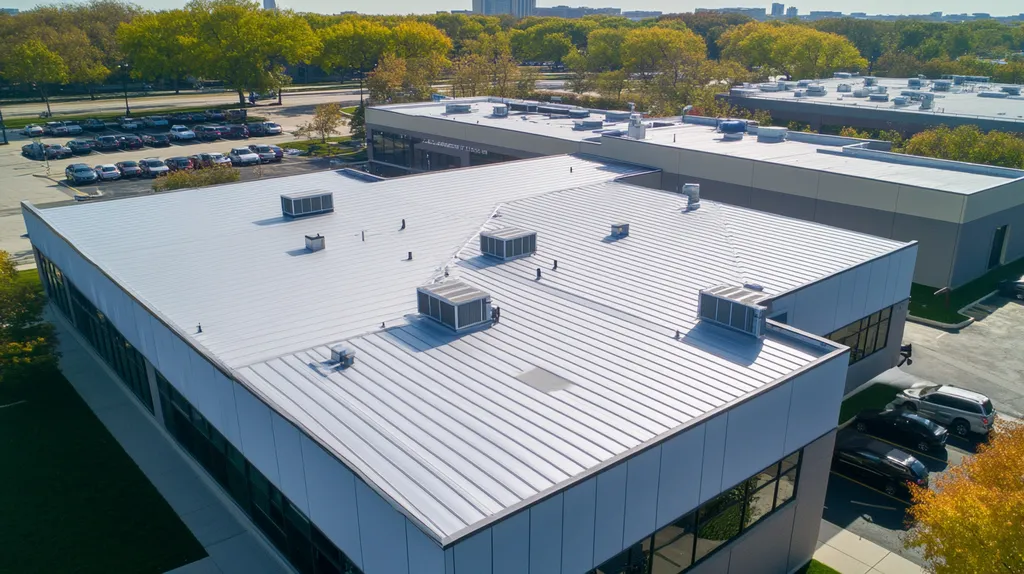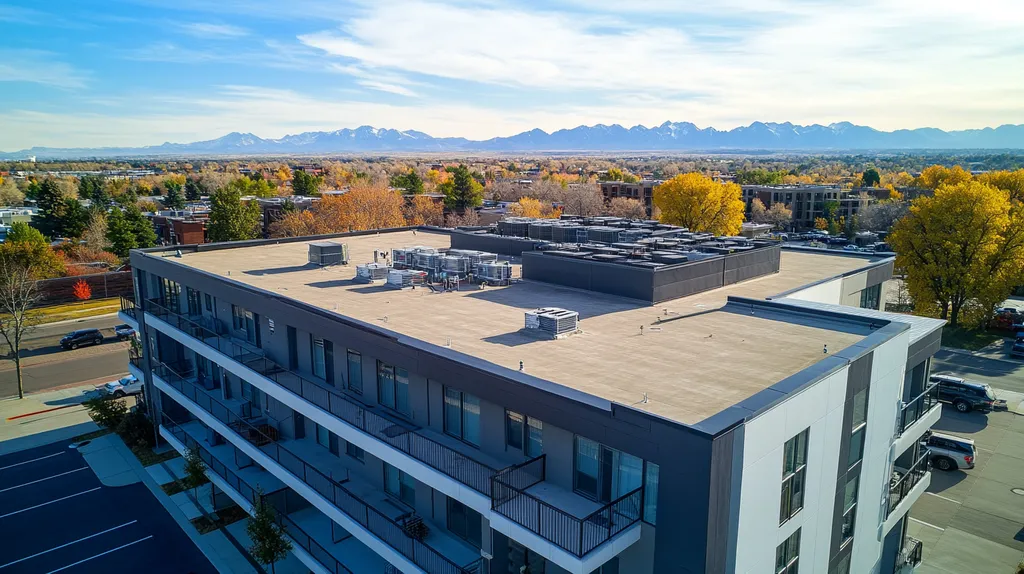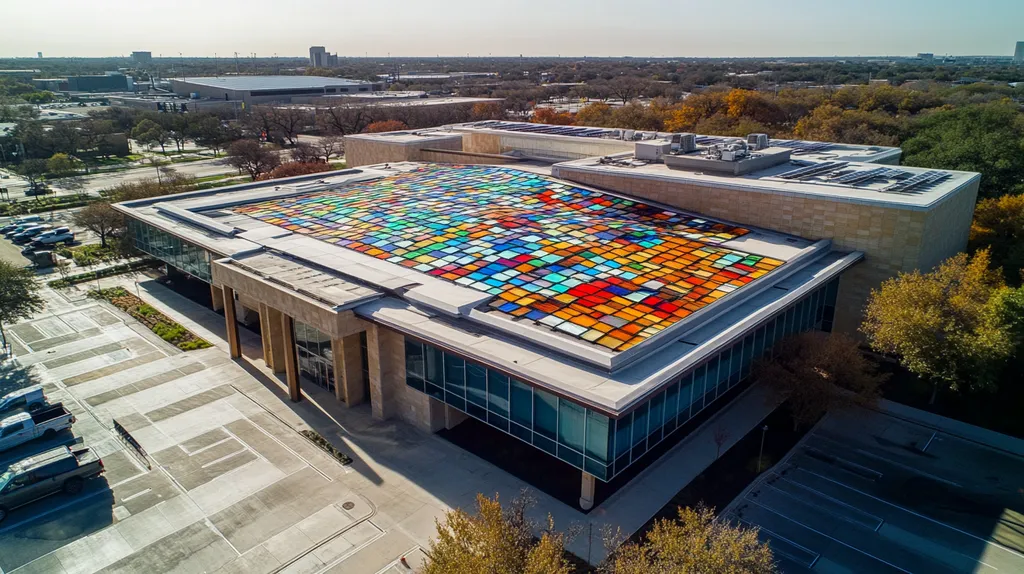Recent data reveals that 45% of commercial roofing projects face compliance violations with landmark regulations, resulting in millions of dollars in fines and structural safety risks annually.
As building codes evolve and sustainability requirements tighten, property owners increasingly find themselves navigating complex regulatory frameworks that govern roofing installations.
This comprehensive analysis examines prevalent industry myths surrounding commercial roof installation compliance, their practical implications, and evidence-based solutions that protect both investments and occupant safety.
SECTION 1: COMMON MISCONCEPTIONS
Many commercial property owners underestimate the complexities surrounding roofing compliance, which can have serious consequences. A staggering 30% of building projects encounter compliance issues, often stemming from ignorance of regulations such as local zoning laws and building codes. This section aims to clarify common misconceptions about commercial roofing to help property owners avoid potentially expensive mistakes.
Ignoring Local Zoning Laws
A prevalent misconception among property owners is that zoning laws do not apply to roofing projects. In reality, these regulations govern what types of roofing materials and designs are permissible in a specific area. Neglecting to follow these rules can result in substantial fines or force property owners to make costly modifications.
Consider a scenario where a property owner decides to upgrade a flat roof to a pitched design for aesthetic and efficiency reasons. However, local zoning restrictions might prevent changes that impact the building’s height or overall profile. Overlooking these codes can quickly lead to compliance headaches.
Furthermore, many property owners fail to obtain necessary permits before starting roofing work. They might assume that minor repairs do not require approval. Local authorities can issue stop-work orders for noncompliance, causing interruptions and escalating costs.
To navigate local zoning laws effectively, property owners should stay informed and work with professionals who understand these regulations. This proactive approach can significantly reduce the risk of compliance pitfalls.
Overlooking Building Code Updates
Another common misconception is that buildings remain compliant with codes indefinitely once they pass inspection. In truth, building codes are subject to frequent updates to keep pace with advancements in materials and safety practices. Assuming a property built years ago still meets current standards can create serious safety risks.
For example, older buildings may not comply with modern energy efficiency or storm resistance requirements. Employing outdated materials can expose a property to vulnerabilities that contemporary codes are designed to mitigate.
Property owners should routinely check for updates to building codes, especially when planning renovations or repairs. The best strategy is to engage professionals who are well-versed in the latest requirements and their implications for roofing choices.
Noncompliance can lead to substantial fines or, worse, jeopardize the safety of tenants and visitors. Moreover, neglecting recent code changes can complicate insurance claims if property damage occurs.
Believing All Roofs Are Created Equal
A widely held myth is that all roofing systems operate with the same level of efficiency and durability. In reality, different roofing materials are designed for specific applications, influenced by factors such as building usage, climate, and local regulations.
For instance, a single-ply membrane might be optimal for a low-slope roof in a temperate climate, but it could prove inadequate for a sloped roof subjected to heavy rainfall. Property owners who fail to acknowledge these distinctions risk premature roof failures.
Additionally, opting for inferior materials to save on costs can result in significant issues, including leaks and insulation failures. Many also overlook the importance of warranties tied to specific roofing systems, potentially missing valuable protections against future expenses.
By understanding the unique requirements of their buildings, property owners can make informed roofing choices. Partnering with experienced roofing professionals ensures that decisions align with both local regulations and the characteristics of available materials. Notably, proper maintenance scheduling further enhances the performance and longevity of roofing systems (source: 1800 New Roof).
SECTION 2: PRACTICAL IMPLICATIONS
Understanding and adhering to roofing regulations is critical for commercial property owners, as non-compliance can lead to severe implications affecting both safety and costs. Failing to meet updated safety standards may result in hefty fines, expensive repairs, or even business shutdowns during inspections. As regulations evolve and tighten, recognizing these potential consequences is essential for property owners and facility managers to avoid significant financial setbacks. This section will delve into the legal repercussions of non-compliance, its impact on structural integrity and safety, and how it affects energy efficiency and sustainability.
Non-Compliance and Legal Consequences
Disregarding roofing regulations can lead to dire legal consequences for property owners. Non-compliance can incur substantial fines, result in legal action, or necessitate the temporary closure of businesses until violations are addressed. For instance, a facility that disregards fire safety codes might be shut down during inspections, halting operations and resulting in revenue loss.
Additionally, property owners may face liability claims if issues stemming from non-compliant roofing materials lead to accidents or injuries. This financial burden can escalate rapidly, making compliance a more prudent choice than facing potential lawsuits.
Moreover, non-compliance can complicate insurance matters. Insurers may deny coverage for damage associated with a non-compliant roof, leaving owners to bear all repair costs. This situation underscores the necessity of staying updated about local regulations to avoid such pitfalls.
Ultimately, the failure to comply with regulations poses risks not just in financial terms but also to a property’s reputation and operational continuity. Owners should prioritize compliance to safeguard their assets and maintain their business integrity.
Impact on Structural Integrity and Safety
Non-compliant roofing can pose serious threats to a building’s structural integrity. For example, roofs that do not adhere to load-bearing standards may sag or even collapse under weight, presenting catastrophic safety risks to employees and visitors alike.
Additionally, subpar materials or improper installation can lead to leaks and water damage, compromising insulation and structural components. The resulting deterioration not only incurs costly repairs but also threatens the overall safety of the building.
Consider the case of a roof collapse in a commercial warehouse, a stark reminder of the consequences of neglecting regulatory specifications. Such incidents illustrate how failing to comply with standards can turn an ostensibly compliant building into a site of disaster.
Investing in compliant roofing solutions can proactively mitigate these structural risks, creating a safer environment for all those who occupy the space. By prioritizing adherence to safety regulations, property owners can protect their investments and enhance the wellbeing of everyone involved.
Effects on Energy Efficiency and Sustainability
Compliance with roofing regulations often correlates with enhanced energy efficiency. Many current regulations encourage the use of energy-efficient materials that help lower heating and cooling costs. Ignoring these standards may result in inflated energy expenses, negatively impacting the operating budget.
For instance, a roof that does not utilize energy-efficient insulation or reflective materials may cause HVAC systems to work harder, leading to significant losses in potential savings. This not only affects profitability but also runs contrary to sustainability initiatives.
Additionally, sustainable roofing practices support environmental efforts. Properties that invest in environmentally compliant roofing systems can take advantage of incentives, such as tax breaks or rebates, which may be lost through non-compliance.
In conclusion, adhering to roofing regulations significantly benefits a building’s operational efficiency and environmental impact. Property owners prioritizing compliance can realize long-term savings while contributing to a more sustainable future.
SECTION 3: COST OF MISINFORMATION
Misinformation in commercial roofing can have severe financial implications for property owners. When regulations are misunderstood or ignored, it can lead to hefty fines and penalties that strain already tight budgets. A recent study found that property owners face an average fine of $20,000 for each instance of non-compliance. This section will examine the significant financial consequences tied to misleading information about roof installations, shedding light on the risks involved.
Financial Penalties and Fines
Ignoring roofing regulations can bring about serious financial burdens for property owners. Regulatory agencies are increasingly diligent in enforcing compliance, resulting in penalties that can severely disrupt budgets. For instance, non-compliance with energy efficiency standards can lead to fines reaching up to $50,000.
In addition to fines, property owners often incur other costs related to compliance issues, such as legal consultations and remediation efforts. These additional administrative expenses can create a financial strain that compounds the initial penalties.
Moreover, non-compliance can lead to increased insurance premiums. Insurance providers frequently adjust rates based on compliance status, further stretching limited financial resources.
Given the unpredictable nature of compliance costs, staying aware of current regulations is essential for all building owners.
Increased Maintenance and Repair Costs
Misinformation doesn’t just result in fines; it also leads to inflated maintenance and repair costs. Using inappropriate materials due to misunderstandings of regulations can accelerate wear and tear on roofing systems. Consequently, property owners might face the necessity of early roof replacements.
Routine inspections often reveal structural issues stemming from non-compliant installations. Addressing these issues in emergencies can be both costly and disruptive to business operations.
Additionally, prioritizing short-term savings over compliance often leads to long-term financial burdens. Initial savings from a lower-cost installation can quickly disappear as repair costs accumulate over time.
This cycle of misinformation creates a snowball effect, magnifying the financial impact throughout the lifespan of the roof.
Loss of Reputation and Business
A reputation for non-compliance can prove detrimental to a company’s operations. Word-of-mouth travels quickly in the industry, and potential tenants or clients may shy away from properties with poor roofing practices. This can directly result in lost revenue as properties struggle to attract and retain occupants.
Furthermore, regulatory non-compliance can tarnish a company’s brand image. Dissatisfied clients or partners may sever ties, adversely affecting business stability.
The costs associated with improving a damaged reputation can be staggering. Property owners may need to invest in marketing, compliance training, and outreach programs to rebuild trust.
Ultimately, misinformation regarding commercial roof installations does not merely have financial repercussions; it can jeopardize the entire future of a business.
SECTION 4: REALITY CHECK
In today’s fast-paced commercial roofing environment, remaining compliant with building codes is not merely a guideline; it’s a fundamental requirement. Non-compliance can lead to hefty fines, unsafe structures, and significant liability issues. Regulations like the International Building Code delineate essential materials and installation practices that are critical for ensuring roof safety and durability. Property owners must actively engage with these standards to avert serious repercussions.
Understanding Current Building Codes
Building codes are multifaceted and differ widely by region. These regulations outline stipulations regarding materials, installation techniques, and safety benchmarks that must be met for a compliant roofing system. For example, certain codes may mandate minimum insulation levels to promote energy efficiency.
Property owners need to frequently review these codes, as they evolve in response to technological advancements and safety imperatives. Non-compliance may not only lead to physical safety risks but can also result in denied insurance claims when damage occurs. Collaborating with knowledgeable contractors who are updated on local codes is essential for maintaining compliance.
By understanding and adhering to current building codes, property owners can enhance both the safety and market appeal of their buildings.
Recognizing Climate-Specific Requirements
Environmental factors significantly influence roofing requirements. Buildings in hurricane-prone areas must meet stricter wind resistance standards, while those in colder climates must address snow load and insulation concerns.
Overlooking these climate-specific considerations can lead to premature roofing failures, costly repairs, and reduced energy efficiency. Properties in arid areas may need reflective materials to minimize heat absorption, whereas regions with heavy rainfall require advanced waterproofing techniques to prevent leaks.
By staying attuned to climate-related requirements, property owners not only protect their investments but also ensure that roofs perform optimally throughout their lifespan.
The Role of Licensed Contractors
Engaging licensed contractors is crucial for achieving compliance with building regulations. Their expertise guarantees both proper installation and effective navigation through complex regulatory requirements. Using unlicensed contractors often introduces risks that can result in dangerous non-compliance.
Moreover, licensed contractors typically offer warranties that shield property owners from costs associated with installation errors. It is vital for property owners to verify contractors’ licensure and relevant experience to prevent costly oversights.
Ultimately, leveraging the specialized knowledge of licensed contractors enhances compliance while significantly contributing to the structural integrity and longevity of commercial roofs.
SECTION 5: EVIDENCE-BASED ALTERNATIVES
As regulatory requirements for commercial roofing become increasingly stringent, property owners face heightened stakes in ensuring compliance. Non-compliance can lead to substantial fines and even the interruption of business operations. Fortunately, there are evidence-based strategies for mitigating these risks effectively. This section highlights the necessity of routine inspections, the selection of compliant and sustainable materials, and adherence to OSHA safety guidelines, providing a clear roadmap toward responsible roofing practices.
Implementing Routine Inspection Schedules
Routine inspections are vital for maintaining compliance and preserving the integrity of a commercial roof. Data from the Roofing Contractors Association indicates that property owners can identify and address potential issues through regular assessments, ideally conducted at least twice a year. This proactive approach not only extends the life of the roofing system but also helps ensure adherence to all relevant building codes.
Timely inspections allow maintenance teams to verify that the roof remains in good standing with current regulations, minimizing the risk of costly fines. Furthermore, a consistently well-maintained roof contributes to improved energy efficiency, significantly enhancing overall building performance.
Ignoring inspection schedules can lead to concealed damage that might only come to light during an emergency. The National Roofing Contractors Association warns that such neglect can result in increased leaks, insulation problems, and even hazardous mold growth, ultimately affecting property value.
Leveraging technology, such as drone inspections, can streamline evaluation processes, allowing for efficient inspections without extensive manual labor. This innovation not only facilitates thorough assessments but also minimizes disruptions to daily operations.
Selecting Compliant and Sustainable Materials
The choice of roofing materials is crucial for both regulatory compliance and sustainability goals. Many jurisdictions now mandate that roofing systems meet specific energy efficiency standards to combat rising energy costs. Selecting compliant materials helps property owners fulfill their legal obligations while simultaneously reducing energy consumption.
Reflective roofing materials, for instance, minimize heat absorption, which translates to lower cooling costs. The U.S. Department of Energy estimates that utilizing such materials can result in energy savings of up to 20% annually.
Moreover, incorporating materials with recycled content aligns with both regulatory frameworks and broader sustainability initiatives. These choices enhance a building’s appeal, as environmentally friendly practices increasingly resonate with tenants and buyers alike.
By collaborating with knowledgeable material suppliers, property owners can ensure their roofing material selections adhere to local regulations. This proactive engagement not only streamlines the installation process but also helps avoid potential complications in the future.
Following OSHA Safety Guidelines
Compliance with OSHA guidelines transcends mere statutory adherence; it fundamentally safeguards lives and protects financial investments. Observing these regulations significantly reduces the risk of workplace accidents during installation or maintenance, where violations could lead to serious injuries or fatalities, inflicting immense financial and reputational harm.
Research indicates that workplaces equipped with robust safety protocols experience up to a 50% decrease in incident rates. Adopting a proactive safety culture—including the use of personal protective equipment (PPE) and routine safety briefings—substantially minimizes risks associated with roofing work.
Training staff on OSHA standards cultivates a culture of safety that enhances employee morale and operational efficiency. This commitment not only protects the workforce but also contributes to timely project completions.
By embedding safety measures into the roofing workflow, property owners can achieve compliance with federal laws while also lowering insurance premiums. This strategy creates a beneficial scenario that enhances both workplace safety and financial performance.
SECTION 6: TEST AND VERIFY
In the world of commercial roofing, ensuring compliance is not merely an administrative task; it represents a commitment to safety and financial prudence. Studies indicate that non-compliant roofs can lead to repair costs soaring beyond 30% of the initial installation expenses. For property owners, understanding and adhering to intricate regulations, maintaining detailed records, and participating in ongoing education are vital for ensuring legal compliance. This section outlines crucial steps for testing and verifying roofing compliance.
Navigating the Permitting Process
Understanding the permitting process is essential for a successful commercial roof installation. Neglecting to obtain the required permits can result in significant fines and project delays. Since each municipality has its own rules, being well-versed in local codes becomes critical.
Property owners should conduct thorough research on local regulations before initiating any roofing project. Consulting with an informed contractor can greatly streamline this process, ensuring all necessary permits are secured. For instance, the approval of roofing materials may be required to uphold sustainability and safety standards.
Non-compliance jeopardizes not just the project itself but can also hinder future property sales and leasing opportunities. Prospective buyers or tenants are likely to favor properties that adhere to regulations, making compliance a key factor in investment decisions.
By actively engaging in the permitting process and establishing a timeline for permit applications, property owners can avoid common compliance pitfalls and keep roofing projects on schedule.
Conducting Regular Inspections and Record-Keeping
Regular inspections are critical for maintaining compliance and prolonging the lifespan of a commercial roof. Documenting each inspection provides essential maintenance records, which are particularly valuable in the event of disputes. Many manufacturers mandate proof of routine inspections for warranty validation.
Property owners should aim for a routine inspection schedule, ideally conducted twice a year or following significant weather events. Inspections should evaluate potential damage, general wear, and compliance with current codes. Utilizing a focused checklist during inspections can streamline the process and ensure no detail is overlooked.
Effective record-keeping is equally vital. Organizing maintenance documents, inspection reports, and contractor correspondence enables easy access and serves as a safeguard against potential legal issues.
Furthermore, a well-maintained documentation history can enhance property value. Prospective tenants or buyers may perceive meticulous records as indicative of responsible property management, positively influencing their purchasing decisions.
Engaging in Industry Workshops and Legal Consultations
To remain compliant, property owners must stay informed about industry developments. Attending workshops and seeking legal consultations provides access to crucial knowledge related to zoning laws, building codes, and innovations in roofing technology.
Workshops present valuable networking opportunities, allowing property owners to connect with experts and peers facing similar challenges. By sharing best practices, attendees benefit from the insights of seasoned professionals.
Legal consultations shed light on the intricacies of compliance obligations. Understanding the legal landscape surrounding roofing can avert costly oversights. For example, owners might be unaware of the repercussions associated with non-compliance in energy efficiency standards mandated by local or federal regulations.
Engaging legal experts early in the roofing project assists in identifying potential obstacles and ensuring compliance from the outset. This proactive approach can lead to significant savings on potential legal fees down the line.
The Bottom Line
With 45% of commercial roofing projects facing compliance violations and regulatory fines reaching $50,000 per incident, property owners cannot afford to ignore landmark regulations.
The evidence demonstrates that successful commercial roof installations depend on three critical factors: thorough understanding of current building codes, engagement with licensed contractors, and implementation of regular inspection protocols.
Property owners who invest in compliance measures typically save 30% on long-term maintenance costs while protecting their assets from legal complications.
As regulations continue to evolve and sustainability requirements increase, staying informed through industry workshops and maintaining detailed documentation becomes essential for protecting commercial investments.
The path forward requires a commitment to evidence-based practices and proactive compliance management to ensure both regulatory adherence and structural integrity.
FREQUENTLY ASKED QUESTIONS
Q. What common misconceptions about commercial roof installation should owners be aware of?
A. Many property owners mistakenly believe zoning laws do not apply to their roofing projects. Neglecting these regulations can lead to fines and costly modifications, as local codes often govern permissible roofing styles and materials. It is crucial to stay informed and consult with professionals aware of the relevant regulations.
Q. What are the practical implications of ignoring regulations for an industrial roof?
A. Ignoring roofing regulations can lead to severe legal consequences, including substantial fines and potential business shutdowns during inspections. Substandard installations not only jeopardize structural integrity but can also lead to lasting safety risks for occupants, making compliance essential for safety and financial health.
Q. How does misinformation impact costs related to commercial roof installations?
A. Misinformation can lead to hefty fines and increased maintenance costs due to inappropriate material choices. Property owners often face unexpected penalties and legal fees, amplifying financial burdens and complicating adherence to evolving regulations. Staying informed about current standards reduces these risks significantly.
Q. Why is understanding building codes critical for commercial roof installations?
A. Building codes dictate essential safety, material, and installation practices necessary for compliant roofing systems. Regularly reviewing these regulations ensures that property owners avoid fines and maintain structural integrity. Engaging knowledgeable contractors helps navigate these requirements efficiently, ensuring long-term compliance and safety benefits.
Q. How can property owners adopt evidence-based strategies for roofing compliance?
A. Implementing routine inspections, selecting compliant materials, and following safety guidelines are essential strategies. Regular inspections help identify potential issues early, while compliant materials align with energy efficiency standards. Adhering to OSHA guidelines ensures a safe work environment, thus mitigating risks associated with roofing installations.
Q. What steps should owners take to navigate the roofing permitting process?
A. Familiarize yourself with local regulations and secure necessary permits before initiating any roofing work. Consulting knowledgeable contractors can streamline this process and ensure compliance. Proper permitting avoids costly fines and project delays while maintaining your property’s integrity and market appeal.
Q. How can building owners ensure the ongoing compliance of their industrial roof?
A. Engaging in regular inspections, maintaining detailed records, and participating in industry workshops are effective practices. Routine assessments help to identify compliance issues promptly, while thorough documentation serves as a safeguard against legal disputes. Staying updated through workshops ensures awareness of evolving regulations.











